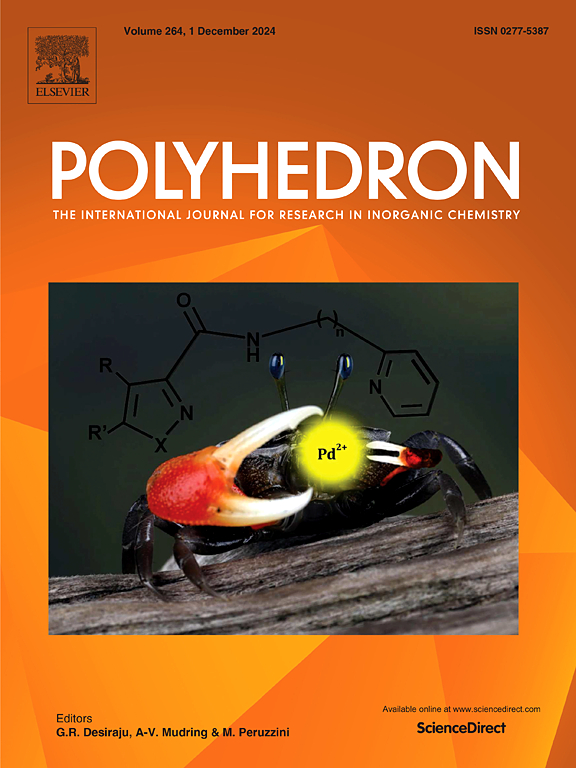Synthesis and structural studies of 1-naphthyl and mesityl ligand bearing organotellurium(II and IV) derivatives
IF 2.4
3区 化学
Q2 CHEMISTRY, INORGANIC & NUCLEAR
引用次数: 0
Abstract
We report the synthesis and single crystal X-ray studies of air- and moisture-stable unsymmetrical organotellurium(II) and organotellurium(IV) derivatives bearing mesityl and 1-naphthyl ligands. The organotellurium(IV) derivatives, RR’TeCl2 (1) and RR“TeCl2 (2), [R = 2-(4,4′-NO2C6H4CH = NC6H3-Me), R′ = 1-naphthyl, R″ = mesityl], were prepared by the treatment of RHgCl with R’TeCl3 and R”TeCl3 respectively in chloroform solvent at room temperature. The organotellurium(II) derivatives, RR’Te (3) and RR“Te (4) were prepared by reducing compounds 1 and 2 in dichloromethane:water solvent. Along with these we also developed compound R’(CH3COCH2)TeCl2 (5) through the treatment of R’TeCl3 with acetone at room temperature. All five compounds were characterized using 1H NMR, 13C{1H}-NMR, 125Te{1H}-NMR, IR, ES-MS and UV spectroscopic techniques and elemental analysis. Additionally, compounds 3, 4 and 5 were confirmed by single-crystal X-ray studies. The crystal packing diagram of 3 shows intermolecular C![]() H∙∙∙O and C
H∙∙∙O and C![]() H∙∙∙Te interactions that are within the Σ rvdw (H,O) of 2.72 Å and (H,Te) of 3.28 Å for the two atoms, giving rise to 1D supramolecular motifs via self-assembly. The crystal packing of 3 also displays an interesting centrosymmetric dimeric unit via C
H∙∙∙Te interactions that are within the Σ rvdw (H,O) of 2.72 Å and (H,Te) of 3.28 Å for the two atoms, giving rise to 1D supramolecular motifs via self-assembly. The crystal packing of 3 also displays an interesting centrosymmetric dimeric unit via C![]() H∙∙∙O interactions. This synthon is based on reciprocal C
H∙∙∙O interactions. This synthon is based on reciprocal C![]() H···O H-bonding interactions of the nitro ligand bearing phenyl fragment. Based on Bent’s rule, we also conclude that the sharing of s-character in these molecules is greater through the mesityl ligand than the tolyl, 1-naphthyl and 4-anisyl organic fragments. The order of electronegativity of these organic fragments in these telluroethers will be mesityl < 4-tolyl < 1-naphthyl < 4-anisyl.
H···O H-bonding interactions of the nitro ligand bearing phenyl fragment. Based on Bent’s rule, we also conclude that the sharing of s-character in these molecules is greater through the mesityl ligand than the tolyl, 1-naphthyl and 4-anisyl organic fragments. The order of electronegativity of these organic fragments in these telluroethers will be mesityl < 4-tolyl < 1-naphthyl < 4-anisyl.

含有机碲(II和IV)衍生物的1-萘基和甲酰基配体的合成和结构研究
本文报道了含甲酰基和1-萘基配体的空气稳定和湿稳定不对称有机碲(II)和有机碲(IV)衍生物的合成和单晶x射线研究。在氯仿溶剂中,用R ' TeCl3和R ' TeCl3分别处理RHgCl,制备了有机碲(IV)衍生物RR ' TeCl2(1)和RR ' TeCl2 (2) [R = 2-(4,4 ' - no2c6h4ch = NC6H3-Me], R ' = 1-萘基,R″=甲酰基]。通过在二氯甲烷:水溶剂中还原化合物1和2,制备了有机碲(II)衍生物RR 'Te(3)和RR 'Te(4)。与此同时,我们还通过丙酮在室温下处理R’tecl3,得到了化合物R’(CH3COCH2)TeCl2(5)。采用1H NMR、13C{1H}-NMR、125Te{1H}-NMR、IR、ES-MS、UV等光谱技术和元素分析对5个化合物进行了表征。此外,化合物3、4和5通过单晶x射线研究得到了证实。3的晶体填充图显示了两个原子在Σ rvdw (H,O)为2.72 Å和(H,Te)为3.28 Å范围内的分子间CH∙∙∙O和CH∙∙Te相互作用,通过自组装产生1D超分子基序。通过CH∙∙∙O相互作用,3的晶体包装也显示出一个有趣的中心对称二聚体单元。该合成子是基于硝基配体与苯基片段之间的相互CH···O氢键相互作用。根据Bent规则,我们还得出结论,通过甲酰基配体,这些分子中s-特征的共享比甲基、1-萘基和4-茴香基有机片段更大。在这些碲醚中,这些有机碎片的电负性顺序为:甲酰基;4-tolyl & lt;1-naphthyl & lt;4-anisyl。
本文章由计算机程序翻译,如有差异,请以英文原文为准。
求助全文
约1分钟内获得全文
求助全文
来源期刊

Polyhedron
化学-晶体学
CiteScore
4.90
自引率
7.70%
发文量
515
审稿时长
2 months
期刊介绍:
Polyhedron publishes original, fundamental, experimental and theoretical work of the highest quality in all the major areas of inorganic chemistry. This includes synthetic chemistry, coordination chemistry, organometallic chemistry, bioinorganic chemistry, and solid-state and materials chemistry.
Papers should be significant pieces of work, and all new compounds must be appropriately characterized. The inclusion of single-crystal X-ray structural data is strongly encouraged, but papers reporting only the X-ray structure determination of a single compound will usually not be considered. Papers on solid-state or materials chemistry will be expected to have a significant molecular chemistry component (such as the synthesis and characterization of the molecular precursors and/or a systematic study of the use of different precursors or reaction conditions) or demonstrate a cutting-edge application (for example inorganic materials for energy applications). Papers dealing only with stability constants are not considered.
 求助内容:
求助内容: 应助结果提醒方式:
应助结果提醒方式:


